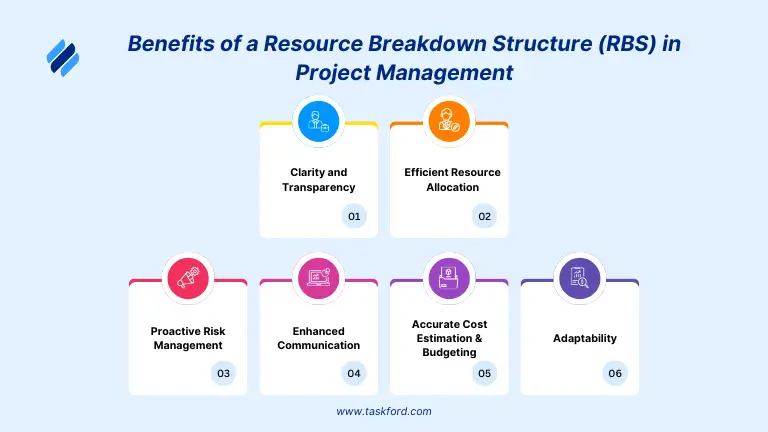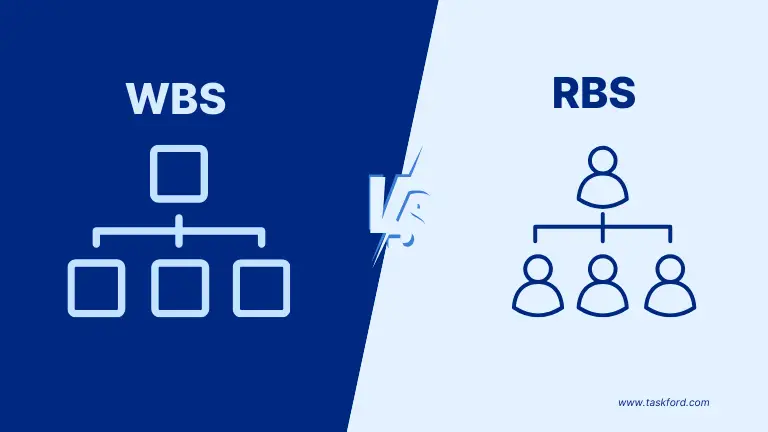What is Resource Breakdown Structure (RBS)? The Ultimate Guide for Project Managers
Learn how a Resource Breakdown Structure (RBS) streamlines resource management. Explore RBS vs. WBS, and implementation steps for better project management
Managing resources effectively is crucial for any project’s success. A Resource Breakdown Structure (RBS) is a key tool that helps project managers organize, allocate, and track resources efficiently. This hierarchical structure allows teams to categorize resources systematically, making project execution smoother.
In this guide, we will dive deep into what RBS is, why it is essential, its types, how it differs from Work Breakdown Structure (WBS), and how to implement it in your projects.
What is a Resource Breakdown Structure (RBS)?
A Resource Breakdown Structure (RBS) is a hierarchical framework that systematically categorizes and organizes all essential project resources, including human resources, materials, equipment, and services. It provides a clear and comprehensive view of the resources needed to complete a project successfully, facilitating planning and control.

For example, in a mining project, the RBS might include mining sites, processing plants, heavy equipment like excavators, and software tools for logistics management.
Key Characteristics of RBS
- Hierarchical Structure: Resources are categorized into different levels based on their type and function.
- Project-Specific Customization: The RBS can be tailored to fit the unique needs of any project, from small startups to massive industrial undertakings
- Resource Allocation Tool: It identifies both available resources and gaps, ensuring nothing is overlooked.
- Budget and Cost Estimation: By detailing resources, it supports accurate financial planning.
- Integration with WBS: The RBS pairs seamlessly with the Work Breakdown Structure to connect resources to specific tasks
A well-defined RBS ensures that resource allocation is transparent, well-documented, and optimized for productivity.
Why Do You Need a Resource Breakdown Structure (RBS) in Project Management?
The importance of RBS is detailed in its ability to enhance project management in several ways:

1. Clarity and Transparency
The RBS provides a crystal-clear view of all resource requirements. This reduces misunderstandings among team members and ensures everyone is on the same page about what’s needed and when.
2. Efficient Resource Allocation
With a detailed breakdown, you can assign the right people, materials, and tools to the right tasks. This precision prevents waste and maximizes productivity.
3. Proactive Risk Management
By identifying resource needs upfront, the RBS helps spot potential risks—like equipment shortages or budget overruns—before they derail your project. According to PMO Risk Management Best Practices, this proactive approach is key to staying ahead of challenges.
4. Enhanced Communication
A structured RBS fosters better coordination among stakeholders. When everyone understands resource allocations, collaboration improves, and miscommunication fades.
5. Accurate Cost Estimation & Budgeting
With an organized structure, teams can estimate resource costs accurately, ensuring that the project stays within budget. This minimizes financial risks and improves overall cost efficiency.
6. Adaptability
An often-overlooked perk: the RBS serves as a record for future projects. By documenting resource use, sharpens your estimation skills over time.
In short, a Resource Breakdown Structure brings order to the chaos of resource management, paving the way for smoother execution and better results.
Types of Resource Breakdown Structure (RBS)
A well-structured Resource Breakdown Structure (RBS) categorizes resources into different types based on their role in the project Here are the primary types:

1. Human Resources
Human resources refers to the people responsible for carrying out the project tasks. This category includes all personnel involved in the project, categorized by roles, departments, or skill sets. Properly allocating and managing human resources ensures a balanced workload, preventing overuse or underutilization of team members.
For example, in a software development project, this might include developers, testers, and UI designers.
2. Materials
Material resources include all physical items required to complete the project successfully. These are tangible assets necessary for production, construction, or any physical deliverable. Proper material resource planning helps in procurement, storage, and utilization without unnecessary waste.
For instance, in a construction project, this would include cement, steel, bricks, and other building materials
3. Equipment and Tools
This category includes all machines, tools, and hardware required for the project. These resources vary based on the industry and project complexity. Proper allocation of equipment prevents downtime and ensures productivity remains high.
For instance, a mining project would require specialized drilling machines and conveyor belts, whereas a small business office setup would only need laptops, printers, and meeting room technology.
4. Technology and Software Resources
In today’s digital world, technology and software resources play a critical role in project execution. These digital assets support planning, execution, collaboration, and monitoring.
A software development team may require coding platforms, cloud computing, and testing tools, while a manufacturing business might depend on ERP software, inventory management systems, and industrial automation tools.
5. Financial Resources
Financial resources refer to the monetary support required to complete the project. Proper financial planning ensures that funds are allocated effectively, avoiding unnecessary expenses or financial constraints.
For example, a startup software company might secure venture capital funding, whereas a government infrastructure project might rely on public funds or loans.
Resource Breakdown Structure (RBS) vs. Work Breakdown Structure (WBS)
The Work Breakdown Structure (WBS) and Resource Breakdown Structure (RBS) are key project management tools with distinct purposes. The WBS breaks down the project into manageable work components (e.g., deliverables like "Build Walls"), focusing on "what" needs to be done for planning and scheduling. The RBS organizes the project’s resources (e.g., "Carpenters," "Wood") into categories, addressing "with what" the work is accomplished for resource allocation and cost management. While the WBS defines the scope and tasks, the RBS details the resources required, making them complementary tools in project execution.

Here’s a concise table summarizing the differences and complementary nature of the Work Breakdown Structure (WBS) and Resource Breakdown Structure (RBS):
| Feature | Work Breakdown Structure (WBS) | Resource Breakdown Structure (RBS) |
|---|---|---|
| Focus | Task-oriented: breaks down the project into deliverables and work packages. | Resource-oriented: categorizes resources needed to complete tasks. |
| Purpose | Defines the scope of work, scheduling, and progress tracking. | Ensures proper resource allocation, cost estimation, and risk management. |
| Structure | Hierarchical breakdown of work into phases, tasks, and subtasks. | Hierarchical categorization of resources based on type and function. |
| Primary Elements | Tasks, work packages, milestones, deliverables. | Human resources, materials, equipment, technology, financial resources. |
| Output | A structured work plan that guides task execution and scheduling. | A structured resource plan that identifies and allocates project resources. |
| Used For | Planning and organizing project deliverables. | Planning and managing resource availability and allocation. |
| Relationship to Cost | Helps estimate time and cost based on deliverables and work efforts. | Helps estimate cost based on resource needs and utilization. |
| Integration | Requires resource assignment for execution. | Supports the WBS by ensuring necessary resources are available for assigned tasks. |
How They Complement Each Other
The WBS and RBS work together seamlessly in project management. The WBS provides the roadmap of tasks and deliverables, while the RBS ensures the necessary resources are identified and allocated to execute those tasks. For example, a WBS task like "Build Walls" relies on RBS elements like "Carpenters" and "Wood" to be completed, making them interdependent tools for effective planning and execution.
How to Implement a Resource Breakdown Structure in Your Projects
To implement an RBS, follow these detailed steps, which build on the initial key points and provide a structured approach:

Step 1: Define Project Scope & Objectives
Begin by thoroughly understanding the project’s scope and its WBS. The WBS, a hierarchical decomposition of the project into manageable work components, serves as the foundation. For example, for a software development project, the WBS might include phrases like "Requirements Gathering," "Design," and "Implementation." This step ensures the RBS aligns with the project’s objectives and tasks, facilitating a seamless integration.
Step 2: Identify Required Resources
For each task in the WBS, identify the specific resources required. Resources can include human resources (e.g., developers, testers), equipment (e.g., servers, development tools), materials (e.g., software licenses), facilities (e.g., office space), and financial allocations (e.g., budget for tools). For instance, "Design" might require graphic designers and design software, while "Implementation" might need programmers and testing environments. This step ensures all resource needs are accounted for, preventing oversight.
Step 3: Categories Resources
Organize these resources into categories and subcategories for clarity and management. Common categories include:
- Human Resources: Broken down by role (e.g., Project Manager, Developer), department (e.g., IT, Marketing), or skill set (e.g., Java expertise, UX design).
- Equipment and Tools: Such as computers, project management software, or specialized machinery.
- Materials and Supplies: Including raw materials, software licenses, or office supplies.
- Financial Resources: Budget allocations for each resource type.
- Other: Licenses, permits, or external services.
This categorization aids in tracking, budgeting, and allocation, ensuring resources are grouped logically for efficient management.
Step 4: Create the RBS Hierarchy
Develop a hierarchical structure for the RBS, starting with the broadest categories at the top and becoming more specific as you descend. This can be visualized as a tree diagram or a table. For example:
- Level 1: Resources
- Level 2: Human Resources, Equipment, Materials
- Level 3: Under Human Resources – Developers, Testers; Under Equipment – Servers, Laptops
- Level 4: Under Developers – Front-end, Back-end
This hierarchy, often created using tools like Excel, project management software, or diagramming tools like Creately, ensures a clear, organized view of all resources, facilitating planning and control.
Step 5: Assign Resources to WBS Elements
Map resources to specific tasks or deliverables in the Work Breakdown Structure to ensure alignment between work and resources. For example, assign "Front-end Developers" to the "UI Design" task and "Servers" to the "Deployment" task.
This step ensures every task has the necessary resources allocated, enhancing task execution and accountability. It also helps in resource leveling, ensuring no over-allocation or under-utilization occurs.
Step 6: Monitor & Optimize Resource Utilization
During project execution, continuously monitor how resources are being used against the RBS. Track metrics like resource utilization rates, workload, and costs to identify any discrepancies. For example, if a task is delayed due to insufficient developer hours, adjust by reallocating resources or hiring contractors. This step involves using project management software for real-time tracking and taking corrective actions to keep the project on track, ensuring deadlines and budgets are met.
Final Thoughts
A well-structured Resource Breakdown Structure (RBS) is a game-changer in project management. It not only ensures efficient resource planning and allocation but also improves cost control, risk management, and communication. When integrated with a Work Breakdown Structure (WBS), it creates a powerful framework for project execution.
By implementing RBS effectively, you can streamline your projects, avoid resource-related bottlenecks, and achieve project success with greater efficiency. If you're looking to enhance your project management strategy, adopting RBS is a must!
Making work simpler,
smarter, and more connected
Join our waitlist and be notified first.

Related Blog
Subscribe for Expert Tips
Unlock expert insights and stay ahead with TaskFord. Sign up now to receive valuable tips, strategies, and updates directly in your inbox.






